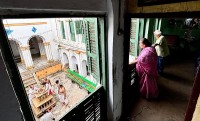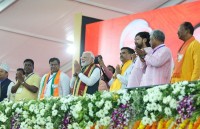Full text of PM Modi's speech at the ASEAN Business and Investment Summit
Kuala Lumpur, Nov 21 (IBNS) Following is the full text of Prime Minister Narendra Modi's speech at the ASEAN Summit 2015 in Malaysia:
Tan Sri Dato Dr Mohd Munir Abdul Majid, Chairman of the ASEAN Business Advisory Council,
Dato Ramesh Koddamal, Co-Chair of the ASEAN-India Business Council,
Business Leaders of ASEAN,
Members of the ASEAN Business Community,
Distinguished Guests,
Ladies and Gentlemen.
I am very happy to be here with you. I feel honoured to address this privileged gathering of the leaders who have transformed South East Asia into one of the most dynamic regions of the world. I congratulate you for this achievement. I also congratulate you on the creation of One ASEAN Community which you are going to sign off tomorrow.
India and ASEAN are natural partners. Our ties date back to ancient times. They continue to serve as a bridge between our countries and regions.
Friends! I have been saying that the 21st century belongs to Asia. I say this because of the track record of the ASEAN countries. Together, ASEAN’s ten member countries form an economic powerhouse. ASEAN has emerged as one of the largest economic zones in the world. Last fifteen years have seen your rapid and yet stable growth. Your Macro-economic stability has been the main reason for growth and stability in South East Asia. With good governance, futuristic infrastructure and focus on new age technologies, you have created excellence.
In simple things like tourism, you have done miracles. Once again, I compliment the leadership and people of ASEAN countries for what they have achieved.
When I analyse the Asian miracle, I find that small countries of ASEAN and a big country like China, both have done well. This shows that growth depends more on the spirit of people rather than the size of population. I have had personal relations with many leaders of this region. I have also visited a number of places a number of times. Even as Prime Minister, my engagements with the Asian leadership started as soon as I took over. I met a number of ASEAN leaders in the last Summit too.
My government took office nearly 18 months ago. The Indian economy faced serious challenges. A high fiscal deficit, a high current account deficit, a large number of stalled infrastructure projects and persistent inflation were among them.
It was obvious that reforms were needed. We asked ourselves the question – Reforms for what? What is the aim of reform? Is it just to increase the measured rate of GDP growth? Or is it to bring about a transformation in society? My answer is clear: we must REFORM TO TRANSFORM.
In short, reform is not an end in itself. Reform for me is just a way station on the long journey to the destination. The destination is the transformation of India. We have to take the fruits of development to the margins of our geography and to the bottom of our demography. We have to touch lives, while reaching for the sky.
By almost every major economic indicator, India is doing better than when we took office 18 months ago.
• GDP growth is up and inflation is down
• Foreign investment is up and the Current Account Deficit is down.
• Tax revenues are up and interest rates are down.
• The fiscal deficit is down and the rupee is stable.
Obviously, this did not happen by accident. And the world economy is not exactly doing well. This success is the result of a series of concerted policies. We have embarked on a course of fiscal consolidation. We have entered, for the first time, into a monetary framework agreement with the Reserve Bank to curb inflation.
Even while cutting the fiscal deficit, we have substantially increased productive public investment. This has been made possible in two ways. Firstly, we have imposed carbon taxes on fossil fuels. We have taken the bold step of de-controlling diesel prices and thereby eliminated energy subsidies, and have in fact imposed taxes on fossil fuels. We have increased the cess on coal by 300%. Globally, there is much talk of carbon taxes. We have actually acted. Secondly, we have reduced wasteful expenditure through innovative methods including targeting subsidies to the deserving through technology.
Overall, there is increased confidence within and outside the country. The IMF and World Bank have expressed even better hope for our economy this year and after. The Economist magazine this week stated that “India is in healthier shape than any other big emerging economy.”
However, as I said, our aim is not mere reform, but “reform to transform”. Macro-economic stability is good. But to transform India, much more needs to be done. We have begun a series of concerted steps. These include structural and institutional reforms.
Agriculture remains India’s mainstay in terms of providing livelihood. We have introduced a series of simple but powerful structural reforms. There was a tendency to divert subsidised fertiliser for the production of chemicals. We have found a simple but very effective solution: by neem-coating the fertiliser, it becomes unsuitable for diversion. We are now moving towards universal neem-coating. This has already saved billions of rupees of diverted farm subsidies.
We have also introduced Soil Health Card. This tells every farmer the condition of his or her soil and then enables him to choose the right crop, best quantity and mix of inputs.
We have launched a housing for all program, one of the most ambitious in the world. It involves building 20 million urban houses and 29.5 million rural houses, totalling nearly 50 million. While the programme will make sure no Indian is houseless, it will also generate a large amount of employment - that too, mainly for the unskilled, the semi-skilled and the poor.
We have undertaken major improvements in the transport sector. Our major ports witnessed a 4.65% growth in traffic and an 11.2% increase in operating income, in 2014-15 despite a global contraction in trade volume.
The pace of award of new highway works has increased from 9 km/day in 2013-14 to 23 km/day currently. These will have large multiplier effects throughout the economy.
We were committed to restore credibility in the process of allocation of natural resources. My government has intervened with legislative and administrative measures to improve the supply of critical inputs and raw materials. They include Coal, other minerals and spectrum. The hallmark of this intervention is allocation through transparent auction.
We started the Jan Dhan Yojana. In less than a year, we opened 190 million new bank accounts. On Social security front, we have launched innovative and attractive schemes for insurance and pension. We have also set up MUDRA Bank to fund the small traders who were unfunded so far. More than six million small traders have already availed the loans.
While expanding the banking services, we are also taking steps to strengthen the Banking system. Credible and capable bankers have been appointed to head banks. For the first time since banks were nationalised 46 years ago, private sector professionals have been appointed in key positions. We have taken concerted action to revive stalled infrastructure projects – We have started a major revamp of the power sector. These measures will also benefit our banks.
Let me now turn to issues of investment, which may be of more direct relevance to you.
In a break with over 65 years of tradition, we have involved India’s States in foreign policy. The Ministry of External Affairs has been asked to work with the States. When I visited China, a state-to-state summit was also held. And states have been asked to create export promotion councils. Making the States think globally is yet another reform with potential to transform.
Our aim is to create jobs for more than a billion young hands. To provide this, the share of manufacturing must reach around 25% in our GDP. We have launched a campaign called ‘Make in India’ and aggressively worked on the front of Ease of doing business. Reducing complicated procedures, making them available at one platform- preferably online, simplifying the forms and formats has been taken up on war footing. That is how we have jumped up by 12 ranks in the World Bank’s Ease of Doing Business Report of 2016. Industry is realizing the benefits of these changes. Index of Industrial Production in the current year shows a distinct improvement over the previous year. We are working in all ways to make India a global manufacturing hub.
World Class Infrastructure has remained a dream for India. Hence, our maximum focus is on building futuristic infrastructure. By exercising tight control over unproductive expenditure, we have greatly increased capital investment by the Public Sector. To further augment such investments, we are encouraging the PPP model. We are also setting up National Investment and Infrastructure Fund which will help us leverage public investments. We are also coming up with Tax Free Infrastructure Bonds with a view to broaden the corporate bond market and to provide long term finance for infrastructure. We are eager to work with Malaysia, Singapore and other ASEAN countries in this regard.
As a result of our initiatives,
• The sentiments for private investment and inflow of foreign investment have turned positive. Foreign investment is up 40%.
• India has been consistently ranked as the most attractive investment destination by several global agencies and institutions.
• India has also improved its UNCTAD ranking of investment attractiveness. Against 15th so far, now we are at 9th place.
• India has also jumped 16 places on the World Economic Forum’s global competitive index after five years of decline in the list.
• MOODY’s have upgraded the outlook for India.
Campaigns like Digital India and Skill India are designed to prepare the people to take part in this process. We have witnessed exponential growth in the number of start-ups in the recent past. To tap this energy fully, we have launched the Start up India Campaign.
We are aware of the interest of the Global investor community in the potential that India has. In recent months, this interest has gone up. Therefore, to re-vitalize the flow of investments, we have launched the second wave of structural and financial reforms. We are trying to further open up the economy and introduce an element of predictability and stability in taxation system.
To give you some examples:
• We have allowed and enhanced FDI levels in key sectors including Insurance, Defence and Railways.
• Now, most of these FDI sectors have been put on automatic approval route.
• We have also rationalised FDI policies in many sectors, including construction, plantation and medical devices.
• We have now allowed composite caps for Foreign portfolio investors in all sectors where FDI is allowed. Earlier, portfolio investments had a separate cap.
• We have greatly liberalised the licensing regime; to give you one example - we have taken out almost 60% of Defence items out of the licensing process.
• We have ended retrospective taxation.
• We have notified the regulations for the Alternative Investment Funds.
• We have rationalized capital gains tax for Real Estate Investment Trusts.
• We have also decided to defer the implementation of General Anti Avoidance Rules.
• We have introduced the Goods & Services Tax Bill in Parliament. We are hopeful of rolling it out in 2016. This will create a unified system of taxation across the country.
• We have drafted a new bankruptcy code. Formation of the Company Law Tribunal to expedite cases is on the way.
These are just a few examples. Almost on a daily basis, we are trying to remove the bottlenecks that were affecting our growth process. Even early this month, we have taken very dynamic steps to further open up the economy for FDI. With this round of reforms, we are among the most open economies in the world.
Going further, I want to assure you that India is committed to protect Intellectual Property Rights of all innovators. We have taken several initiatives for transparency and online processing in IP administration. A comprehensive National IPR policy is expected by the end of the year. We are moving fast to make sure that our tax regime is transparent and predictable. We are also keen to see that genuine investors and honest tax payers get quick and fair decisions on tax matters.
Friends, India is a land of immense opportunities. To give you some examples: our fifty cities are ready for putting up Metro Rail Systems. We have to build 50 million affordable houses. The requirement of road, rail and waterways is enormous. We have decided to go for renewable energy in a big way - 175 GW. We have to do all this in a short span of time. Our democratic values and an alert judicial system ensure the safety of your investments. We have set the tone of Governance with a long term vision and an open mind. We are particularly working to make India the easiest place to do business.
Friends, Most of the ASEAN economies have done their bit for Asia’s resurgence. Now, it is India’s turn. And we know that our time has come. We are at a take-off stage. I invite you to come and see the winds of change in India. Winds do take time to cross the borders. That is why; I am personally here to invite you. When you come, you will get the wings of a new business environment. And once you are there, I assure you of my full co-operation.
Thank You.
Top Headlines
-
News
CSR in the Crossfire: Professor and practitioners debate over ethics in India Inc. at Kolkata's MCHD talk
October 24, 2025
-
News
Jashanpreet Singh Case: California under fire for licensing undocumented truck driver
October 24, 2025
-
News
India upgrades Technical Mission in Kabul to Embassy, days after Muttaqi's visit to New Delhi
October 22, 2025
-
News
Pakistan, Afghanistan agree to 48-hour ceasefire after deadly border clashes
October 15, 2025
-
News
Afghan Taliban, Pakistan exchange gunfire, dozens killed
October 15, 2025
-
News
Trump hails Netanyahu in Israel after hostage release, declares historic dawn of a new Middle East
October 13, 2025
-
News
Historic dawn of a new Middle East: Donald Trump addresses Israeli Parliament
October 13, 2025
-
News
Shah Rukh Khan receives maiden National Award from President Droupadi Murmu
September 23, 2025
-
News
Kolkata: Ahiritola Yubak Brinda invites Auram to make jewellery for Ma Durga and her family
September 20, 2025
-
News
Israel-US alliance 'never been stronger', Netanyahu says as State Secretary Rubio visit for talks
September 15, 2025





